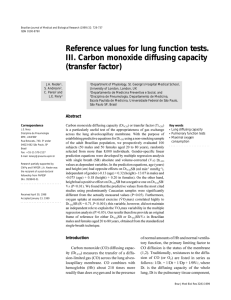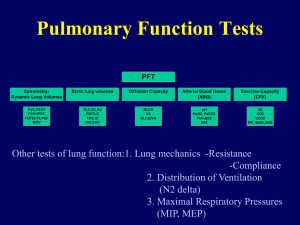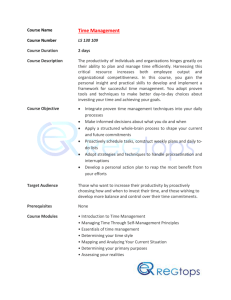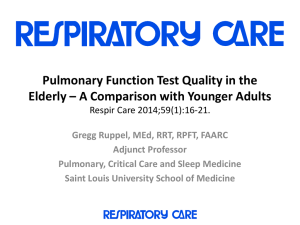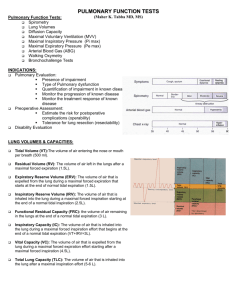Diffusing Capacity
advertisement
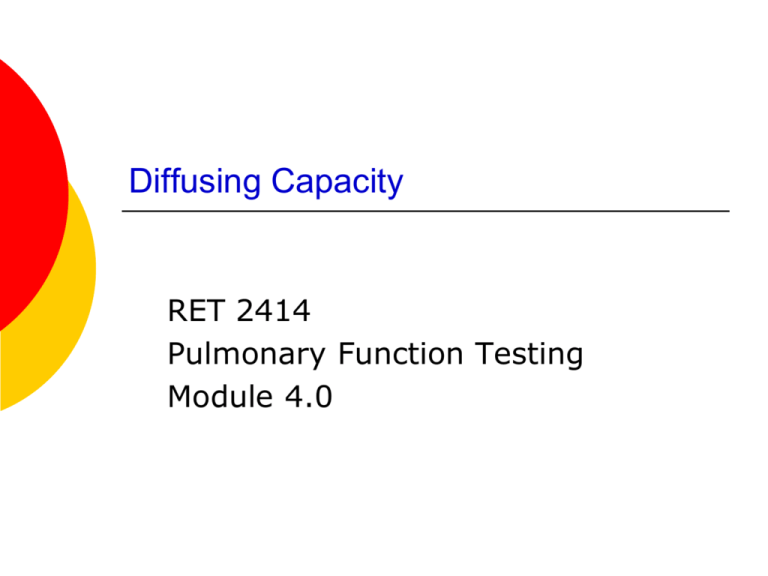
Diffusing Capacity RET 2414 Pulmonary Function Testing Module 4.0 Diffusing Capacity Single Breath Method (DLcosb) (Modified Krogh Technique) DLco measures the transfer of a carbon MONOXIDE (CO) across the alveolocapillary membranes Diffusing Capacity DLcosb CO combines with Hb 210 times more readily than O2 DLco is expressed as: ml of CO/minute/mm Hg (STPD) STPD (0 C, 760 mm Hg, Dry) Diffusing Capacity DLcosb Procedure Unforced exhalation to RV (limited to 6 seconds) Rapid inhalation of a diffusion gas mixture to TLC (from spirometer/demand valve/reservoir) 0.3% CO 10% He (tracer gas) 21% O2 Balance Nitrogen Diffusing Capacity DLcosb Procedure Breath hold at TLC for 10 +/- 2 seconds Rapid exhalation (should not exceed 4 sec) Alveolar gas is collected after a washout volume (0.75-1.0 L) has been discarded (If VC is <2.0 L, washout volume may be reduced to 0.50L) Diffusing Capacity DLcosb Procedure Sample gas volume should be 0.50 – 1.0 L (If VC <1.0L, a sample of <0.50L can be analyzed if deadspace volume has been cleared) Sample is analyzed for the fractional CO and He (tracer gas) concentration Change in He concentration reflects dilution by gas in lungs at RV This change is used to determine the initial CO concentration Diffusing Capacity DLcosb Diffusing Capacity DLcosb DLcosb is then calculated as follows: DLcosb= VA x 60 x Ln FACO0 (PB – 47) x (T) FACOT MEMORIZE ! NOT ! Diffusing Capacity DLcosb Average DLcosb value 25 ml CO/min/mm Hg (STPD) Diffusing Capacity DLcosb Pretest Patient Preparation Should refrain from: Smoking for at least 24 hours prior to testing Consuming alcohol 4 hours prior to test (will reduce DLco) Strenuous exercise before testing (effects pulmonary capillary blood volume) Eating for at least two hours prior to testing (digestion effects pulmonary capillary blood volume) Diffusing Capacity DLcosb Pretest Patient Preparation Should sit for at lest 5 minutes before test (effects pulmonary capillary blood volume) Supplemental O2 should be discontinued at least five minutes prior to testing Diffusing Capacity DLcosb Acceptability Criteria Volume-Time tracing should show smooth, rapid inspiration (<4 sec) from RV to TLC Expiration should be rapid but not forced; 4 seconds or less Diffusing Capacity DLcosb Acceptability Criteria Dead space washout should be 0.75 – 1.00 L (0.5 L if VC is less than 2.0 L) Alveolar sample volume should be 0.5 to 1.0 L Inspired volume should be at least 85% of previously recorded best VC Diffusing Capacity DLcosb Acceptability Criteria Breath hold time should 10 sec +/- 2 sec (No Valsalva or Mueller maneuver) The average of two or more acceptable test should be reported. Duplicate determinations should be within 10% of highest value or 3 ml CO/min/mm Hg Diffusing Capacity DLcosb Significance and Pathology Decreased in: Restrictive Lung diseases Asbestosis Berylliosis Silicosis Idiopathic pulmonary fibrosis Sarcoidosis Systemic lupus erythematosus Scleroderma Diffusing Capacity DLcosb Significance and Pathology Decreased in: Inhalation of toxic gases (alveolitis) Loss of lung tissue Space occupying lesions (tumors) Pulmonary edema Lung resection Radiation therapy (fibrotic changes) Chemotherapy Diffusing Capacity DLcosb Significance and Pathology Decreased in: Emphysema Chronic Bronchitis , Asthma (may or may not be decreased) DLco sometimes used to differentiate between emphysema and chronic bronchitis Diffusing Capacity DLcosb Significance and Pathology In patients with COPD, DLco less than 50% of predicted is accompanied by O2 desaturation during exercise Low resting DLco (<50% - 60% of predicted) may indicate the need for assessment of oxygenation during exercise Diffusing Capacity DLcosb DL/VA DLco is directly related to lung volume in healthy individuals DL/VA is approximately 4-5 ml CO transferred/minute/liter of lung volume Diffusing Capacity DLcosb DL/VA DL/VA is useful in differentiating between restrictive and obstructive disease Obstruction = Low DL/VA ratio Restriction = DL/VA Ratio is preserved Diffusing Capacity DLcosb DLco is affected by: Hemoglobin (Hb) Corrections for Hb concentrations should be applied Low Hb reduces DLco High Hb elevates DLco Carboxyhemoglobin (COHb) Corrections for COHb should be applied High COHb reduces DLco Diffusing Capacity DLcosb DLco is affected by: Alveolar PCO2 Increased PCO2 elevates DLco Hypoventilation Pulmonary capillary blood volume Increased blood volume causes increased DLco Mueller maneuver Increased cardiac output Decrease pulmonary capillary blood volume causes decreased DLco Valsalva maneuver Diffusing Capacity DLcosb DLco is affected by: Altitude above sea level High altitude increases DLco Poor inspiratory effort during testing If less than 85% of VC will decrease DLco

